Super-svelte CAMM2 memory can deliver higher clock speeds, lower latencies, costs, and even better system cooling says MSI
Let's start with the obvious: CAMM2 memory is flat. Initially designed to fit inside mobile devices thanks to its ultra-slim design, CAMM2 has since been heralded as potentially the future of desktop RAM, and we've seen several manufacturers show off super-skinny modules of CAMM2 that may soon be slotting in (or should that be, mounting on?) our desktop PC motherboards.
But beyond looking odd (it can't just be me crossing my eyes looking at a desktop mobo with no RAM sticking up from the board, can it?), there are several potential advantages to the new form factor, at least according to MSI. It live-streamed a deep dive into CAMM2, espousing the benefits of the new standard and why it might show up in your next build (via Wccftech).
Unlike traditional RAM sticks, CAMM2 modules are directly connected to the corresponding CAMM2 interface, rather than via SI (System Interface) «stubs» which limit the bus speed. This more direct connection allows both the inner and outer IMC (Integrated Memory Controller) channels to connect to a single CAMM2 module, which means you can have dual-channel operation on a single module—unlike SO-DIMMs, for example, where you'd need two separate sticks.
CAMM2 motherboards also require few (and shorter) signal traces, cutting down on costs and potentially leading to higher clocks and lower latency.
The modules have a smaller PCB overall compared to traditional RAM sticks of similar capacity, with only a single PMIC (Power Management Integrated Circuit). Not only does this lead to further reduced costs compared to a traditional DIMM, but lower power consumption and less heat.
Speaking of heat, CAMM2 is also said to improve cooling. Essentially, RAM sticking up proud from the motherboard can block airflow to the underneath of a CPU cooler, whereas mounting it flush allows air to pass over the top. Traditional RAM sticks can also get in the way of fan placement and water-cooling system tubing, whereas clever old CAMM2 tucks itself neatly to







